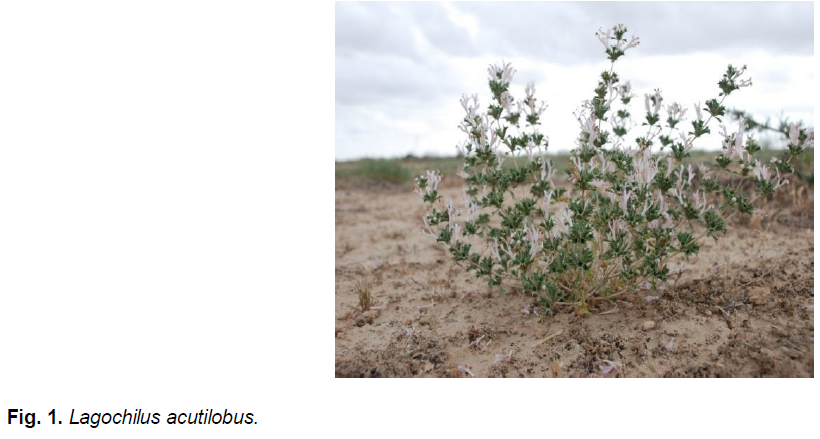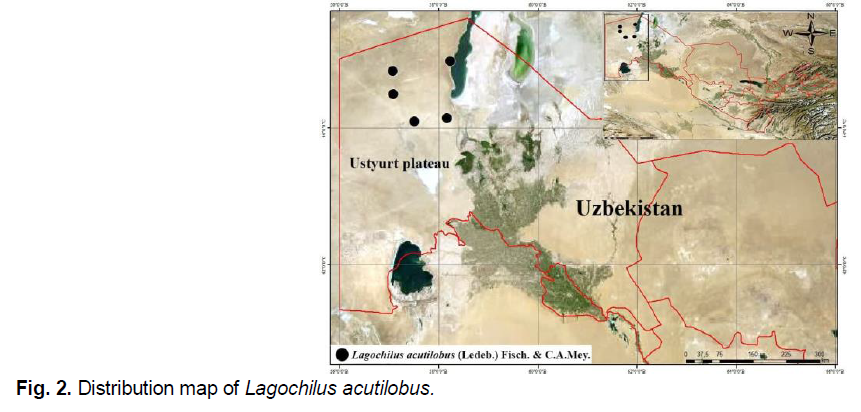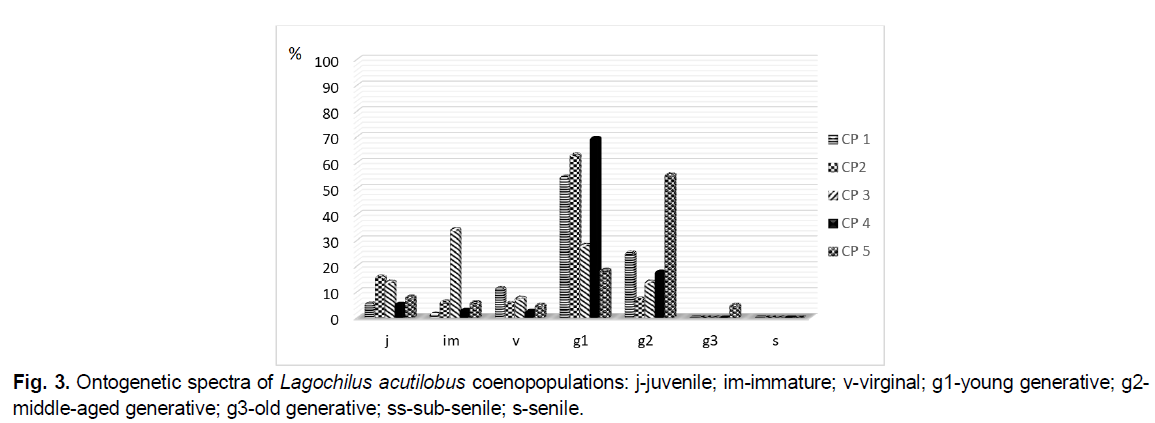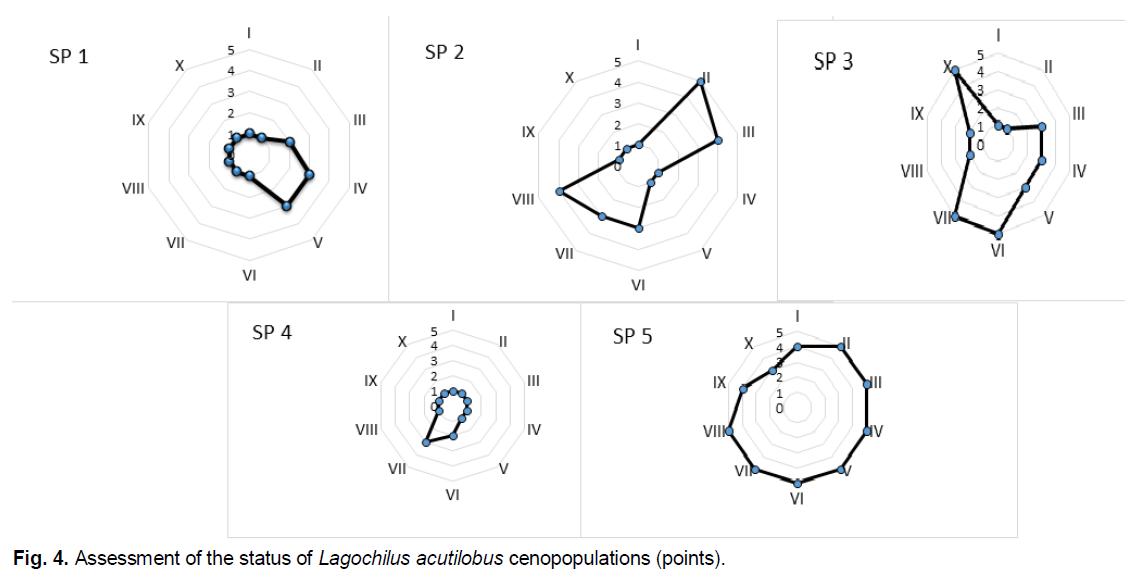Research - (2021) Volume 0, Issue 0
Ontogenetic structure and assessment of the state of coenopopulations of Lagochilus acutilobus (Ledeb.) Fisch. and C.A. Mey in Ustyurt (Uzbekistan)
S.U. Saribaeva1*, H.F. Shomurodov1, A.A. Akhmedov2 and O.S. Abduraimov2Abstract
Lagochilus acutilobus is one of the rare plants in the Karakalpak Ustyurt. The article is devoted to the assessment of the current state of this species. The study showed that in the ecological-cenotic conditions of Ustyurt, the studied cenopopulations are normal, incomplete. Ontogenetic spectra of specific cenopopulations are left-sided and centered, which is associated with the ecological conditions of habitation and fluctuations in weather conditions. Based on the analysis of demographic and population characteristics, the state of coenotic populations of the species was assessed. It was revealed that the curly-bayalysh-wormwood communities (Artemisia terrae-albae, Salsola arbusculiformis and Atraphaxis spinosa) are the ecological optimum for Lagochilus acutilobus.
Keywords
Coenopopulation, demographic and population characteristics, ecological and phytocenotic optimum, lagochilus acutilobus, ontogenetic spectrum, ustyurt.
Introduction
Lagochilus acutilobus (Ledeb.) Fisch. and C.A. Mey of the genus Lagochilus Bunge. L. acutilobus is a polycarpic, semi-erect, sympodially growing, herbaceous perennial. The shoots of renewal are monocyclic. After the death of the primary shoot, the monopodial growth is replaced by a sympodial one. Renewal buds are formed on the root neck of the main root. It grows on sand, takyrs, chalk outcrops, gravelly plumes (Fig. 1).

Figure 1: Lagochilus acutilobus.
This type of Caspian and Aral Sea deserts occurs sporadically in the Uzbek part of Ustyurt. Its main range of this species is located in the northern subzone of Ustyurt, where the oil and gas industry has been developing in recent years. Rare species, which are important elements of the flora, require regular monitoring observations. Research in this area will serve as an important source for subsequent editions of the" Red Book " of the regions (Shatko and Mironova 1986).
The aim of the study was to assess the state of the coenopopulation of Lagochilus acutilobus in Ustyurt. According to H.F. Shomurodov and the authors (2014, 2015), Lagochilus acutilobus is distributed in the northern part of the Karakalpak Ustyurt, in the area of the Belule, Bayterek, Churuk, and Almambet water wells. It forms small groups among the undersized biyurgunnik, in some places its number reaches 21 individuals per 10 m2 (in the area of Beluli), but such an abundance is rare. According to the study of the population strategy, Lagochilus acutilobus is characterized as a rapidly stable species. The species shows features of tolerance on saline soil in the Artemisia terrae-albae-Anabasis salsa-Salsola arbusculiformis complexes, in which the anthropogenic load is absent or weakly expressed. Its tolerance is characterized by a different rate of development of individuals in ontogenesis, the absence of separate ontogenetic age states and low biomass.
Materials and Methods
Research and collection of material were carried out on the territory of the Ustyurt plateau. The ontogenetic structure and density of Coenopopulations (CP) were determined in transects within the limits of one coenosis. The transects were divided into areas of 1 m2 each. Each cenopopulation has 20-30 sites. When characterizing the population structure, we relied on the representation of the characteristic spectrum (Zaugulnova 1994). The ontogenetic structure of coenopopulations was defined as the ratio in the coenopopulation of individuals of different ontogenetic states. An individual was taken as a counting unit. Coenopopulations were characterized according to the classifications of A.A. Uranov and O.V. Smirnova (1969) and "delta-omega" (Zhivotovsky 2001). The following demographic indicators were used for the detailed characterization of coenopopulations: ecological and average density (Odum, 1986).The assessment of the state of coenopopulations was carried out using organizational and population characteristics (Zaugulnova 1994). To do this, the range of each feature was divided into five classes with the same volume on a uniform scale; then each class was assigned a score; the lowest score corresponded to the lowest indicators. The results of the assessments are presented in the form of multi-axis diagrams. Geobotanical descriptions were performed according to the standard method at sites of 100 m (Field Geobotany 1964).
The ontogenetic structure of 5 coenopopulations of Lagochilus acutilobus in the following communities was studied: 1 Coenopopulation (CP 1)-buyurgun-sagebrush community (Artemisia terrae-albae, Anabasis salsa, Anabasis brachiata, Astragalus erioceras, Rhinopetalum karelinii), total projective cover (general projective cover) 20-30%, grows 15 km North of the village of Zhaslyk, in the area of Kosbulak (in the vicinity of the Ustyurt biological station) (N 440094.62, E 0570503.42). CP 2-bayalish- sagebrush community (Artemisia terrae-albae, A. turanica, Asparagus breslerianus, Scorzonera pusilla, Haplophyllum versicolor), general projective cover 12-14%, registered in the Beluli area on takyrovid soil. Geographical coordinates of the coenopopulation: N 440 49' 20.2" E0570 07`29.3". СP 3-biyurgun formation (Anabasis aphylla, Anabasis salsa), general projective cover 20%, was studied in the northwestern part of the Karakalpak Ustyurt-in the area of the Churuk well on fine-grained-gravelly soil. Geographical coordinates of the coenopopulation: N 44052 '30.7" E 570 07` 27.0". CP 4-kurchavnikovo-biyurgunovo-bayalyshevogo community (Salsola arbusculiformus, Anabasis brachiate and Atraphaxis spinosa), general projective cover 10%, coenopopulation was detected in the Kabanbai area (N 44014.501 E 058016.145). CP 5-kurchavkovo-bayalyshevo-sagebrush communities (Artemisia terrae–albae, Salsola arbusculiformis and Atraphaxis spinosa), general projective cover 37%, geographical coordinates N 440 96.305; E 0580 23.008 (Fig. 1).
Results and Discussion
The ontogenetic spectra of Lagochilus acutilobus CP were studied. According to the peculiarities of the species ' biology, the characteristic ontogenetic spectrum for Lagochilus acutilobus is centered. This type of spectrum is formed due to an increase in the life span of individuals in the mature generative state and poor seed germination. The ontogenetic spectra of the studied coenopopulations of L. acutilobus are represented by the following types of spectrum: left-sided (CP 1,2,3,4) centered (CP 5) (Fig. 2).

Figure 2: Distribution map of Lagochilus acutilobus.
Coenopopulations with the left-hand spectrum type. The left-side spectra are single-vertex. In coenopopulations with this type of spectrum, the peak falls on young generative (CP 1 and 2) or immature (CP 3) individuals. This variant of the spectrum is formed with abundant fruiting and rapid rates of development of young individuals. A high proportion of young generative individuals in coenopopulations (1 and 2) is associated with intensive rates of development of individuals in pregenerative age states and rapid transitions to generative states (Fig. 3). The predominance of immature individuals in coenopopulation 3 is primarily associated with the mass death of both young and mature generative individuals due to frost in the spring wound. As studies have shown, in the spring of 2018, after a short-term spring warming (in early March), a cold air flow from the north was observed. Short-term frosts strongly affected the juicy shoots of adults: almost 70-80% of them fell off. The predominance of immature individuals in the coenopopulation is probably due to late seed germination, i.e. after spring frosts. The ontogenetic spectra of the above coenopopulations do not coincide with the characteristic ones.

Figure 3: Ontogenetic spectra of Lagochilus acutilobus coenopopulations: j-juvenile; im-immature; v-virginal; g1-young generative; g2-middle-aged generative; g3-old generative; ss-sub-senile; s-senile.
Coenopopulations with a centered spectrum type. In CP 5, the absolute maximum in the spectrum falls on middle-aged generative individuals (55.78%). Coenopopulations with this type of spectrum are incomplete, they lack senile fractions. The predominance of mature generative individuals in these coenopopulations is associated with the biology of the species, i.e., the long stay of individuals in this ontogenetic state. The absence of old fractions in all the studied coenopopulations is most likely due to the biology of the species (long stay in the mature generative state, short life in the old generative state, and rapid death). It should be noted that this Cenopopulation (CP 5) grows in the causeway terrace of the plateau, where water erosion is sometimes observed. The ontogenetic spectra of cenopopulations with a centered type coincide with the theoretically established spectrum and reflect the biological characteristics of the species.
The highest density was observed in CP 1-2, 25 individual/m2 and CP 3-2, 9 individual/m2, and in the rest it does not exceed 1.4 individual/m2. According to the classification of A. A. Uranov, O.V. Smirnova and L.A. Zhivotovsky, the coenopopulations were distributed as follows. The evaluation of the age ∆ (delta) and efficiency (omega) showed that CP 2 refers to the young (∆=0,31; w=0,16). CP 3 and CP 4 turned out to be transient, in which the values of "delta" and "omega" approach the values of young coenopopulations (∆=0,39-0,40; w=0,68-0,67). CPU 1-mature (∆=0.33; w=0.71) and CPU 5-mature (∆=0,39; w=0,73) (Table 1).
| S.No. CP | Density of Individuals/m2 | Ecological Density of Individuals/m2 | w | Δ | Type CP |
|---|---|---|---|---|---|
| 1 | 2,25 | 2,8 | 0,71 | 0,33 | maturing |
| 2 | 1,15 | 1,7 | 0,16 | 0,31 | young |
| 3 | 2,9 | 5,2 | 0,68 | 0,39 | transient |
| 4 | 1,2 | 1,6 | 0,67 | 0,40 | transient |
| 5 | 1,35 | 1,58 | 0,73 | 0,39 | mature |
Table 1. Demographic characteristics of Lagochilus acutilobus cenopopulations.
The assessment of the state of the coenopopulations of Lagochilus acutilobus showed that the most informative indicators of the organismal traits is the biomass of individuals. The accumulation of total biomass is one of the most informative indicators of plant vitality, which reflects the optimal conditions of plant growth under the influence of biotic and abiotic environmental factors.
The highest value of individual biomass (5 points) was observed in the buyurgun-sagebrush plant community in the northwestern part of the Nukus-Zhaslik road; the average biomass of individuals varies from 6.69 to 7.9 g. The soil of this territory is salty and the projective cover is 10-15%. In CP 5, the biomass of individuals is 4 points, the average value is 5.48-6.68 g.
Under the influence of a number of abiotic factors in the following all coenopopulations, the average value of the biomass of individuals varies from 1.84 to 4.26 (1-2 points). A sharp decrease in annual precipitation in the territory during the transition of plants to the generative stage negatively affected the biomass of individuals. In addition, regular strong winds do not favor the normal development of plants.
The reproductive effort of individuals is one of the self-preserving features in coenopopulations. Especially the complete maturation of seeds causes the enrichment of coenopopulations at the expense of young individuals.
The highest value of reproductive effort was observed (5 points) in the large sagebrush community (CP 2) and in the coenopopulation 5 forming a plant group with the participation of Lagochilus acutilobus. The gradual increase in the percentage of reproductive effort is directly related to the number of generative shoots in plants. The average value (3 points) of reproductive effort is observed in coenopopulation 4 and is about 76.83-80.21%.
The lowest value of reproductive effort was observed in coenopopulations 1 and 3 (1 point) and is about 70.5-73.43%. This fact is most likely associated with unfavorable environmental conditions for shoot formation (poor aeration, less nutrients).
The number of generative shoots in plants forms a direct correlation with the reproductive effort of individuals. Accordingly, a high value of the number of generative shoots is observed in coenopopulations 2 and 5 (4-5 points) and their average value is about 6.33–7.6 pcs. High values of plant height (20.2 cm) and caudex diameter (0.58 cm) were registered in the coenopopulation-5 (5 points). In this selected cenopopulation, the accumulation of spring rains and the waters formed from them is observed in one place. And this had its effect on the amount of moisture in the soil. Such a circumstance determines the high value of the organizational characteristics of individuals.
The average value of plant height and caudex diameter (3 points) is observed in coenopopulations 1 and 3. The height of plants in these coenopopulations ranges from 16.85 to 17.65 cm.
The lowest value of traits (1 point) is observed in the composition of the large-sagebrush plant community (CP 2) and in SP 4, which forms a plant grouping with the participation of lagochilus. In these cenopopulations, the plant height does not exceed 14.6-15.72 cm, and the caudex diameter is 0.41 cm. The condition of the individuals of the above-mentioned cenopopulations was negatively affected by excessive overgrazing throughout the year.
The analysis of population characteristics showed that the maximum value of the density of individuals per 1 m2 of the area (5 points) in most cases corresponds to the proportion of individuals of the young and generative states of plants (CP 3 and CP 5). The projective cover of the view only in the coenopopulation 18 has a high value (5 points).
In CP 2, the density of individuals (3.62 units) and the ecological density of individuals (6.25 units) is 3 points.
This indicator does not show high values in other price populations. The reason is that the seed stock of perennial plants in the soil, common in arid zones, is not always at a high level and this has its effect on the density of individuals in coenopopulations. This is especially pronounced in coenopopulations 1 and 3. Thus, if the density of individuals per 1m2 of the area is 1.27-2.81 pcs., then the ecological density of individuals is 3.4-5.3 pcs.
The proportion of young individuals in coenopopulations depends on the phytocenotic and ecological conditions of the habitat. In flat places with sufficient soil moisture and less projective cover of the grass stand, the proportion of the young fraction in the cenopopulations increases. Its maximum value (5 points) is marked on the main road Nukus-Zhaslyk to the north-east as part of the Buyurgunovo-sagebrush community (Table 2).
| S.No. | Sign | Points | ||||
|---|---|---|---|---|---|---|
| I | II | III | IV | V | ||
| 1 | 2 | 3 | 4 | 5 | 6 | 7 |
| 1 | Individual biomass, g | 1,84-3,05 | 3,06-4,26 | 4,27-5,47 | 5,48-6,68 | 6,69-7,9 |
| 2 | Reproductive Effort, (RE), % | 70,05-73,43 | 73,44-76,82 | 76,83-80,21 | 80,22-83,6 | 83,61-87 |
| 3 | Number of generative shoots, pieces | 1,2-2,48 | 2,49-3,76 | 3,77-5,04 | 5,05-6,32 | 6,33-7,6 |
| 4 | Plant height, mm | 14,6-15,72 | 15,73-16,84 | 16,85-17,96 | 17,97-19,08 | 19,09-20,2 |
| 5 | Caudex diameter, sm | 0,37-0,41 | 0,42-0,45 | 0,46-0,49 | 0,50-0,53 | 0,54-0,58 |
| 6 | The individuals density, 1 m2 pieces. | 1,27-2,05 | 2,06-2,84 | 2,84-3,62 | 3,63-4,41 | 4,42-5,22 |
| 7 | Ecological density of 1 m2, pieces. | 3,4-4,35 | 4,36-5,3 | 5,31-6,25 | 6,26-7,2 | 7,21-8,16 |
| 8 | general projective cover | 1-1,60 | 1,61-2,20 | 2,21-2,80 | 2,81-3,4 | 3,41-4,0 |
| 9 | Proportion g2 - g3, % | 7,78-11,32 | 11,33-14,87 | 14,88-18,42 | 18,43-21,97 | 21,98-25,5 |
| 10 | Proportion j - g1, % | 74,5-78,01 | 78,02-81,53 | 81,54-85,05 | 85,06-88,57 | 88,58-92,12 |
Table 2. Ranking point of Lagochilus acutilobus signs value. Assessment of the state of coenotic populations of Lagochilus acutilobus.
An increase in the life span of individuals in the generative period with a culmination in the middle-aged state in the vast majority of perennial plants, including L. acutilobus, is observed in more favorable habitat conditions. The maximum indicators of middle-aged and old generative individuals (4-5 points) were registered in CP 1, 3, 5.
The assessment of the state of coenopopulations by a set of features revealed that the vast majority of coenopopulations of the studied species are in a pessimal state (Fig.4).

Figure 4: Assessment of the status of Lagochilus acutilobus cenopopulations (points).
Conclusion
Thus, the studied coenopopulations of L. acutilobus are normal, but incomplete. The absence of old fractions in all the studied coenopopulations is most likely due to environmental conditions. The ontogenetic spectra of specific coenopopulations are diverse (left-sided and centered).
The basic ontogenetic spectrum is left–sided, with a peak on pregenerative individuals (young generative ones) and does not coincide with the characteristic one, which is associated with the deterioration of ecological habitat conditions and fluctuations in weather conditions. The predominance of pregenerative factors is also reflected in demographic indicators.
References
Geobotany, F. (1964). By EM Lavrenko and AA Kor chagin. Moskow. Nauka, 3:230.
Jivotovskiy, L.A. (2001). Ontogenetic state, the effective density and classification of the population. Ecology, 1:3-7.
Odum, Yu. (2009). Ecology. Moskow, 2:6-10.
Shatko, V.G., Mironova, L.P. (1986). The state of populations of some rare plants in the Karadag State Nature Reserve. Bulletin of the Main Botanical Garden, 141:61-67.
Shomurodov, H.F., Akhmedov, A., Saribayeva, S.U. (2014). Distribution and the current state of Lagochilus acutilobus (Lamiaceae) in connection with the oil and gas sector development in Uzbekistan. Ecological Questions, 19:45-49.
Shomurodov, H.F., Saribayeva, S.U., Akhmedov, A. (2015). Distribution pattern and modern status of rare plant species on the Ustyurt Plateau in Uzbekistan. Arid Ecosystems, 5:261-267.
Uranov, A.A., Smirnova, O.V. (1969). Classification and main features of development of populations of perennial plants. Bulletin of Moscow Society of Naturalists (Department of Biology), 2:119-134.
Zaugolnova, L.B. (1994). The Structure of the populations of seed plants and monitoring. Resume of Dissertation of Doctor of Biological Sciences, St. Petersburg, p:70.
Author Info
S.U. Saribaeva1*, H.F. Shomurodov1, A.A. Akhmedov2 and O.S. Abduraimov22Samarkand State University, Samarkand, 140104, Uzbekistan
Citation: Saribaeva, S.U., Shomurodov, H.F., Akhmedov, A.A., Abduraimov, O.S. (2021). Ontogenetic structure and assessment of the state of coenopopulations of Lagochilus acutilobus (Ledeb.) Fisch. and C.A. Mey in Ustyurt (Uzbekistan). Ukrainian Journal of Ecology 11 (7), 185-189.
Received: 13-Aug-2021 Accepted: 24-Sep-2021 Published: 27-Sep-2021
Copyright: This is an open access article distributed under the terms of the Creative Commons Attribution License, which permits unrestricted use, distribution, and reproduction in any medium, provided the original work is properly cited.
